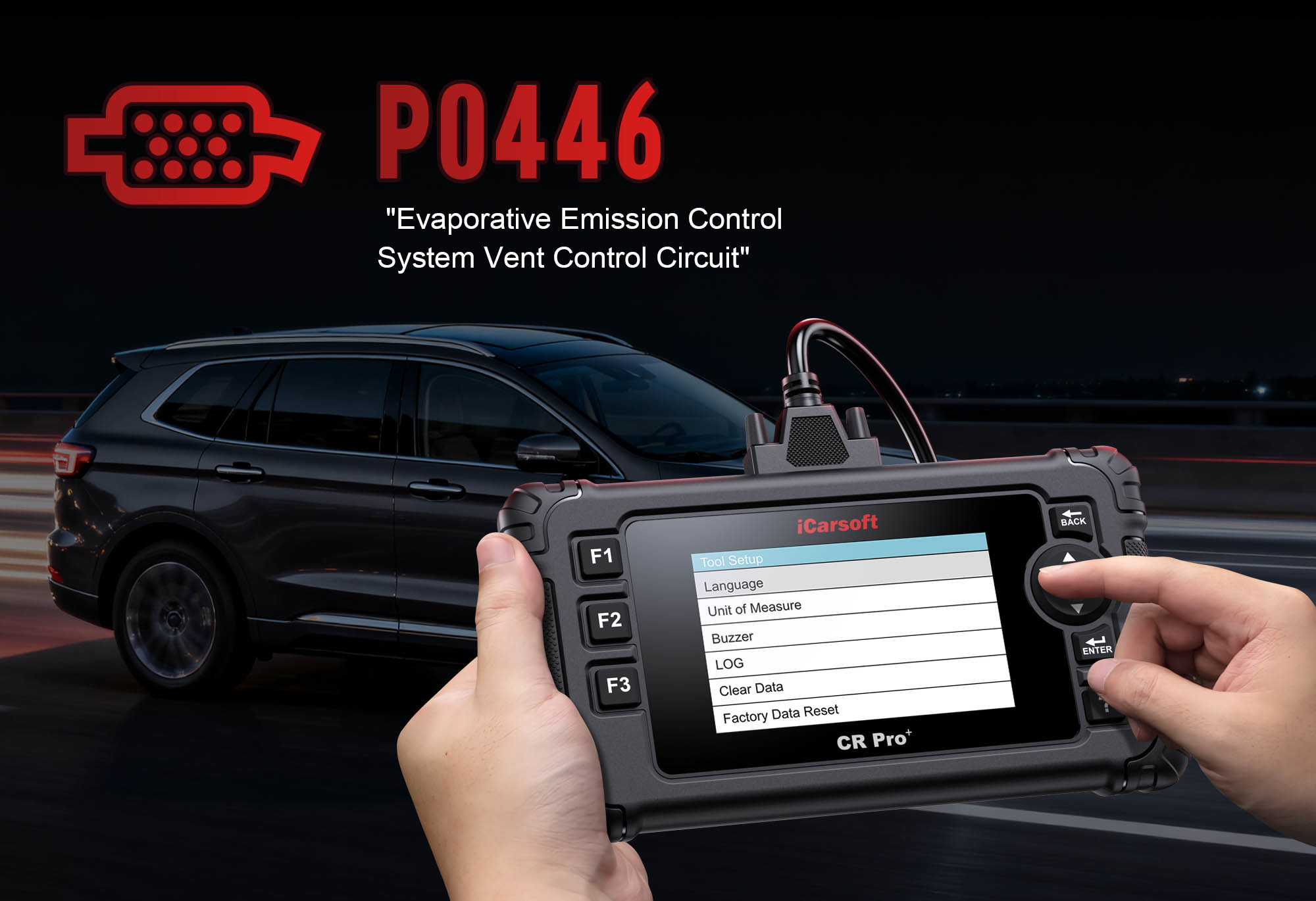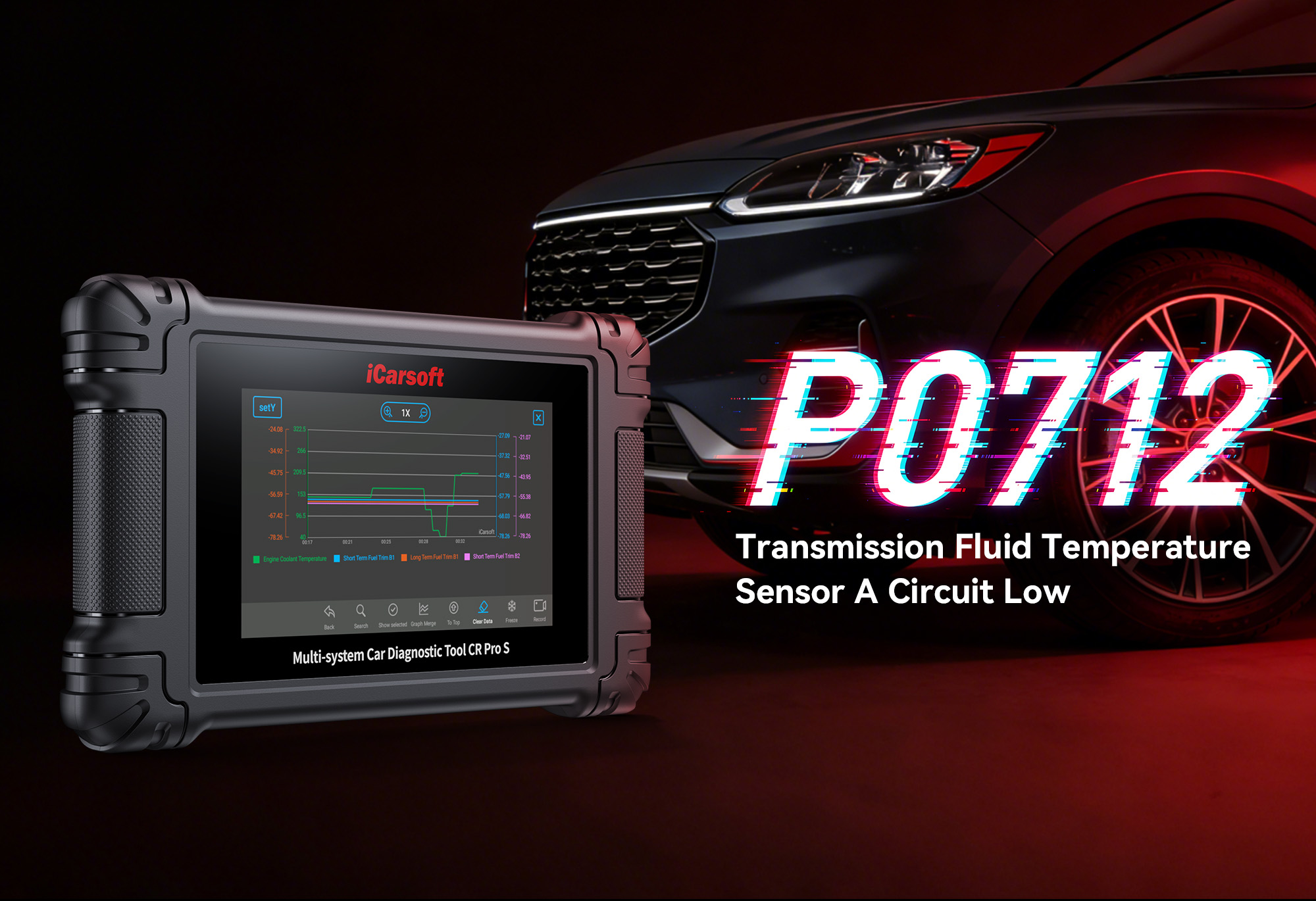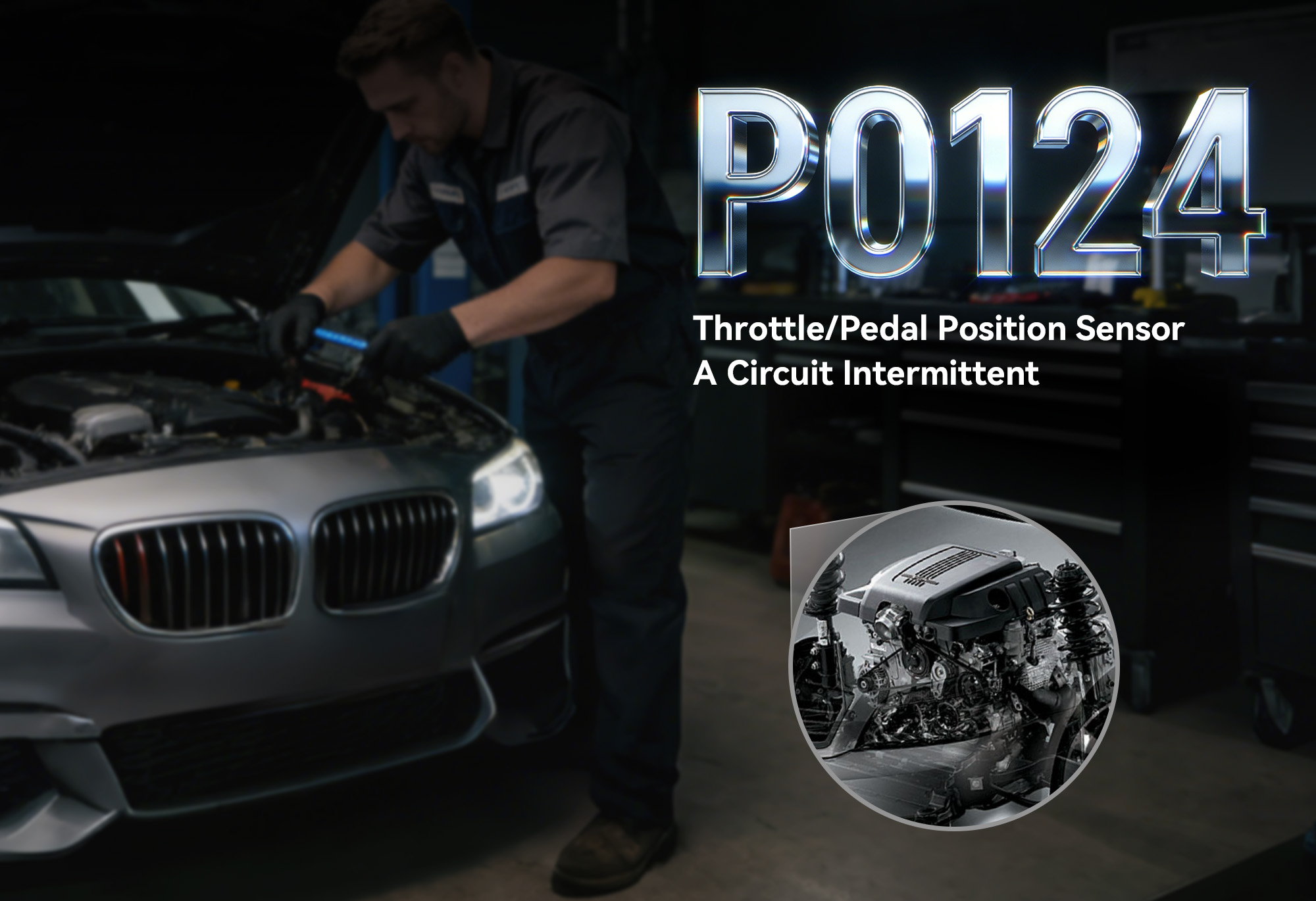Diagnose & Clear P0446 with iCarsoft CR Pro+: Fix EVAP Vent Control Circuit/Valve Issues
If your check engine light illuminates and a scan returns P0446, your vehicle’s Evaporative Emissions (EVAP) system is signaling a critical control failure. This generic OBD-II code stands for "Evaporative Emission System Vent Control Circuit Malfunction"—meaning the Engine Control Module (ECM) cannot properly regulate the EVAP system’s vent valve or has detected a fault in the valve’s electrical circuit.
The EVAP system relies on a vent valve (also called a vent solenoid) to manage pressure and release excess air from the system: during normal operation, the valve opens to let fresh air into the charcoal canister (which stores fuel vapors); during leak tests, the ECM closes the valve to seal the system and check for leaks. When P0446 occurs, the vent valve either gets stuck (open/closed), has a wiring issue, or fails to respond to the ECM’s commands. Left unaddressed, P0446 causes failed emissions tests, fuel odor, and can trigger additional EVAP codes (e.g., P0455 for large leaks).
Basic scanners might only label P0446 as a "vent control fault" but can’t test valve functionality or diagnose wiring issues. The iCarsoft CR Pro+—with its EVAP solenoid activation tests, circuit voltage checks, and system pressure monitoring—solves this. Let’s walk through how to diagnose and resolve P0446.
 iCarsoft CR Pro+ running EVAP vent valve activation test to diagnose P0446
iCarsoft CR Pro+ running EVAP vent valve activation test to diagnose P0446
Understanding P0446: Causes & Key Symptoms
To tackle P0446 effectively, first map its impact on the EVAP system and vehicle performance:
Key Symptoms of P0446
-
Check Engine Light: Illuminates when the ECM detects no response from the vent valve (e.g., valve doesn’t open/close when commanded) or a circuit fault (e.g., broken wire) for 2+ consecutive drive cycles.
-
Fuel Odor: Stuck-closed vent valve traps pressure in the EVAP system, forcing fuel vapors to leak from weak points (e.g., gas cap seal).
-
Failed Emissions Tests: The EVAP system can’t complete leak tests (due to unresponsive vent valve), leading to failed state inspections.
-
Intermittent Performance Issues: Rare, but a stuck-open valve may cause slight fuel efficiency loss (unrecovered vapors) or a "hissing" sound from the rear of the vehicle (air escaping the canister).
-
EVAP System Warning: Some vehicles (e.g., Chevrolet, Dodge) display "Check EVAP System" or "Vent Valve Malfunction" on the dashboard.
Common Causes of P0446
|
Cause
|
Description
|
|
Stuck EVAP Vent Valve
|
Rust, debris, or corrosion causes the valve to stick open or closed—prevents proper pressure regulation (most common cause, ~35% of P0446 cases).
|
|
Faulty Vent Valve Solenoid
|
The electrical coil inside the valve fails, so it doesn’t respond to ECM commands (no "click" when activated).
|
|
Damaged Wiring/Connectors
|
Broken wires, corroded terminals, or loose connectors between the ECM and vent valve disrupt electrical signals (causes ~25% of P0446 cases).
|
|
Clogged Vent Valve Filter
|
A dirty filter (on the valve’s air intake) blocks airflow, mimicking a stuck valve—common in dusty/off-road driving conditions.
|
|
ECM Software Glitch
|
Outdated firmware misinterprets vent valve signals, triggering false P0446 codes (common in 2015+ vehicles).
|
|
Charcoal Canister Blockage
|
A clogged canister creates backpressure, forcing the vent valve to stick—caused by debris ingestion or fuel saturation.
|
Why iCarsoft CR Pro+ Excels at Diagnosing P0446
The CR Pro+ outperforms basic tools with features tailored to EVAP vent system diagnostics—critical for pinpointing P0446’s root cause:
Bi-Directional Vent Valve Testing
Activates the vent valve (open/closed) directly from the scanner to verify responsiveness—no need to disconnect wires. Listen for "clicks" and check airflow to confirm functionality.
Circuit Voltage & Continuity Checks
Measures voltage (12–14V) and ground continuity (<1 ohm) at the vent valve connector—detects broken wires, corroded terminals, or faulty solenoids.
EVAP System Pressure Tracking
Monitors system pressure while testing the vent valve—stuck-closed valve = rising pressure; stuck-open = pressure stays low (quantifies valve performance).
Vehicle-Specific EVAP Diagrams
Preloaded with vent valve locations, wiring schematics, and filter guides for 65+ makes (e.g., Toyota Tacoma, Ford Explorer, Jeep Grand Cherokee).
Vent Valve Filter Alerts
Reminds users to inspect/clean the valve’s air filter (overlooked cause of P0446) and provides OEM part numbers for replacements.
ECM Firmware & Leak Test Tools
Scans for manufacturer software updates (fixes false codes) and runs post-repair leak tests to ensure the entire EVAP system is sealed.
Step-by-Step: Diagnose P0446 with iCarsoft CR Pro+
-
1. Connect & Confirm the Code
1. Plug the CR Pro+ into your vehicle’s OBD-II port (under the dashboard) and power it on.
2. Select your vehicle via Auto VIN Scan (reads VIN in 2 seconds) or manual entry (make/model/year—critical for EVAP system specifics).
3. Navigate to Engine > Fault Codes > Read Codes to confirm P0446. Tap Code Details for vehicle-specific insights (e.g., "Ford: EVAP Vent Valve Not Responding to Close Command" or "Chevrolet: Vent Valve Circuit Low Voltage").
-
2. Check for Related EVAP Codes
P0446 rarely appears alone—scan for companion faults to narrow the root cause:
- P0440: General EVAP System Malfunction (systemic issue, e.g., canister blockage)
- P0442/P0455: EVAP Small/Large Leaks (caused by stuck vent valve)
- P0452/P0453: EVAP Pressure Sensor Low/High Voltage (pressure issues from valve)
- P0691: Vent Valve Control Circuit Low Voltage (wiring fault)
Multiple codes = address systemic issues (e.g., stuck valve + pressure sensor fault) instead of isolated wiring.
-
3. Locate the EVAP Vent Valve
Pinpoint the valve to avoid testing the wrong component—use the CR Pro+’s guidance:
1. Navigate to Component Location > EVAP System > Vent Valve.
2. The scanner displays an undercarriage diagram: the vent valve is typically mounted near the charcoal canister (rear axle area) with a small air filter attached.
3. Note the valve’s connector type (2-pin/3-pin) and mounting position—mark it with tape for easy access during testing.
-
4. Test Vent Valve Functionality (Bi-Directional Test)
The CR Pro+’s core tool for P0446—verifies if the valve responds to commands:
1. Ensure the engine is off and the gas cap is tightly sealed.
2. Navigate to Special Functions > EVAP > Vent Valve Activation Test.
3. Follow on-screen prompts:
- Step 1 (Command Open): Scanner sends a signal to open the valve. Listen for a faint "click" (solenoid activating) and feel for airflow from the valve’s filter.
- Step 2 (Command Close): Send a signal to close the valve. Listen for a second "click" and confirm airflow stops.
4. Interpret results:
- No click + no airflow change = faulty solenoid or circuit issue.
- Click but no airflow = stuck valve or clogged filter.
- Works correctly = ECM glitch or canister blockage.
-
5. Inspect & Clean/Replace the Vent Valve Filter
A clogged filter mimics a stuck valve—resolve this low-cost issue first:
1. Locate the small foam/plastic filter on the vent valve’s air intake (use CR Pro+’s diagram).
2. Remove the filter: if dirty (dust/debris) or oily (fuel vapors), clean with low-pressure compressed air; if damaged, replace with OEM (use CR Pro+’s Part Lookup).
3. Reinstall the filter and repeat the Vent Valve Activation Test—if airflow improves, the filter was the cause.
-
6. Test the Vent Valve Circuit (Wiring & Voltage)
If the valve doesn’t respond, diagnose electrical faults:
1. Disconnect the vent valve’s electrical connector (wear gloves to avoid corrosion).
2. Navigate to Special Functions > EVAP > Vent Valve Circuit Test.
3. Connect the CR Pro+’s test leads to the connector terminals (follow scanner pinout diagram).
4. The scanner measures three critical values:
- Battery Voltage: 12–14V = normal; low = broken wire/loose connector.
- Ground Continuity: <1 ohm = good; high = corroded ground.
- Solenoid Resistance: 10–30 ohms (match manufacturer specs); infinite = faulty solenoid.
5. Fix issues: splice broken wires with heat-shrink connectors; clean corroded terminals with a wire brush + dielectric grease.
-
7. Check for Charcoal Canister Blockage
A clogged canister creates backpressure that sticks the vent valve:
1. Navigate to Special Functions > EVAP > Canister Backpressure Test.
2. The CR Pro+ commands the vent valve open and monitors system pressure—high pressure = clogged canister.
3. Resolve blockage: Remove the canister (use CR Pro+’s diagram) and blow compressed air through it (reverse vapor flow direction); replace if damaged.
-
8. Update ECM Firmware (If Applicable)
Outdated software causes false P0446 codes in 2015+ vehicles:
1. Navigate to Special Functions > ECM > Firmware Check.
2. The CR Pro+ scans for manufacturer updates—follow prompts to install (requires stable Wi-Fi).
3. This resolves cases where the ECM misinterprets vent valve signals (no hardware repair needed).
-
9. Repair & Clear P0446
Fix the root cause based on diagnostics:
- Faulty Vent Valve: Replace with OEM (check CR Pro+’s specs for compatibility, e.g., Bosch 0280142515 for GM).
- Wiring/Corrosion: Repair broken wires or clean terminals with dielectric grease.
- Clogged Filter/Canister: Replace the filter or clean the canister.
- ECM Glitch: Install firmware updates.
Clear the code: Navigate to Engine > Fault Codes > Clear Codes to delete P0446 and related EVAP faults.
-
10. Verify the Repair
Confirm the EVAP system works properly to avoid reoccurrence:
1. Re-test the Vent Valve: Run the Activation Test—valve should click and airflow should change with commands.
2. Run EVAP Leak Test: Use Special Functions > EVAP > Leak Detection Test—scanner seals the system and checks for pressure leaks (no leaks = good).
3. Test Drive: Drive 20 minutes (include highway speeds) to let the ECM recheck the EVAP system.
4. Re-scan: No P0446 return + no fuel odor = successful repair.
5. Check Readiness: Navigate to Readiness Monitors—ensure the EVAP monitor is "Ready" for emissions tests.
Preventing P0446 Recurrence
The CR Pro+ helps maintain a healthy EVAP vent system long-term, avoiding future P0446 codes:
-
Vent Valve Filter Maintenance: Use the CR Pro+’s Service Reminder to clean/replace the filter every 15,000 miles (prevents clogging).
-
Valve Function Tests: Run the Vent Valve Activation Test annually—catch sticking early (before it triggers P0446).
-
Wiring Care: Inspect vent valve connectors during oil changes—apply dielectric grease to prevent corrosion.
-
Canister Protection: Avoid driving over debris that could damage the charcoal canister (mounted near the rear axle).
-
ECM Updates: Check for firmware updates quarterly via One-Key Upgrade—resolves software glitches.
-
Gas Cap Checks: Ensure the gas cap is tightened until it clicks (loose caps worsen EVAP pressure issues).
Conclusion
P0446’s link to EVAP system functionality makes it a critical fault for emissions compliance, but the iCarsoft CR Pro+ simplifies diagnosis with vent valve-specific tools. Unlike basic scanners that only label the code, the CR Pro+ lets you test the valve, check circuits, and verify repairs—eliminating guesswork.
Whether you’re replacing a faulty solenoid ($50–$150), cleaning a $10 filter, or fixing wiring, the CR Pro+ ensures you resolve the root cause—restoring proper EVAP operation, eliminating fuel odors, and passing emissions tests. With this guide, you’ll turn a "vent control fault" into a straightforward repair—no mechanic needed, just professional-grade accuracy.
FAQs About P0446 Code
Q: Can I drive my vehicle with P0446?
A: Yes, but only temporarily. P0446 doesn’t cause immediate engine damage, but it will fail emissions tests and may lead to fuel odor or reduced efficiency. If paired with a flashing check engine light (rare for P0446), stop driving—this indicates a more severe EVAP issue.
Q: Why does P0446 return after replacing the vent valve?
A: Common reasons: 1) Unrepaired wiring/corrosion (the new valve still doesn’t get power), 2) Clogged charcoal canister (backpressure sticks the new valve), 3) Wrong valve (non-OEM valves may not communicate with the ECM). Re-run the CR Pro+’s circuit and canister tests to find the issue.
Q: How much does it cost to fix P0446?
A: Costs vary by cause: Filter cleaning/replacement = $10–$30 (DIY); Vent valve = $50–$150 (DIY); Wiring repair = $20–$50 (DIY); Canister replacement = $150–$300 (DIY/pro); ECM update = $0 (DIY via CR Pro+). Professional repairs add $100–$200 in labor—avoid this with the CR Pro+’s DIY diagnostics.
Q: Will a gas cap replacement fix P0446?
A: Unlikely. A loose/broken gas cap triggers P0442 (small leak) or P0455 (large leak), not P0446. P0446 is specific to the vent valve or its circuit—only fix the gas cap if it’s paired with leak codes (e.g., P0446 + P0442).

 iCarsoft CR Pro+ running EVAP vent valve activation test to diagnose P0446
iCarsoft CR Pro+ running EVAP vent valve activation test to diagnose P0446



